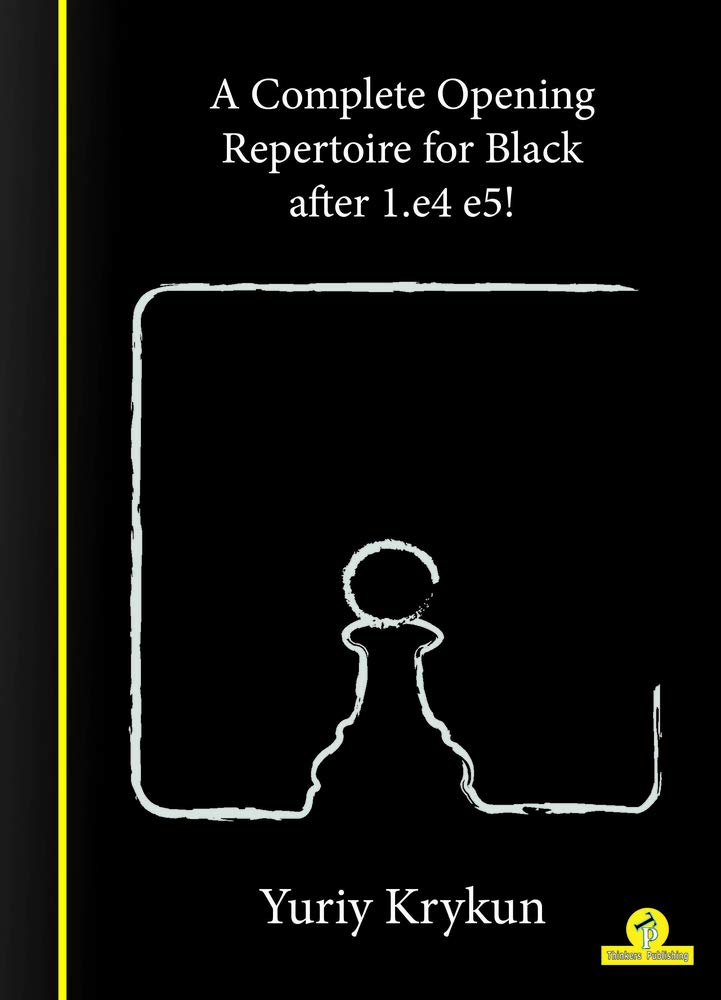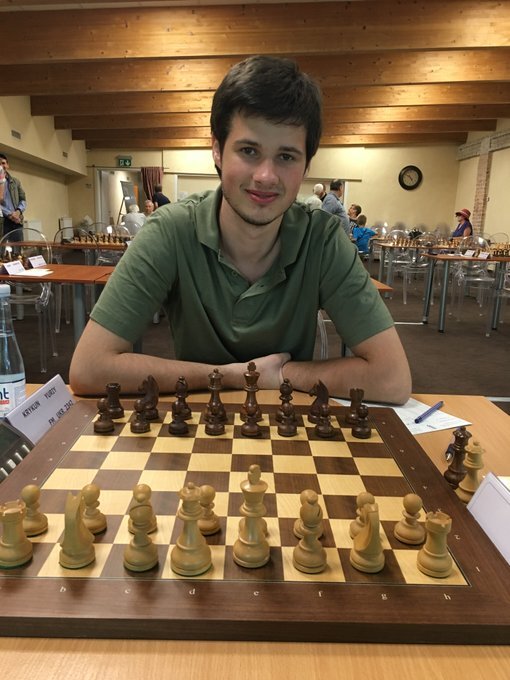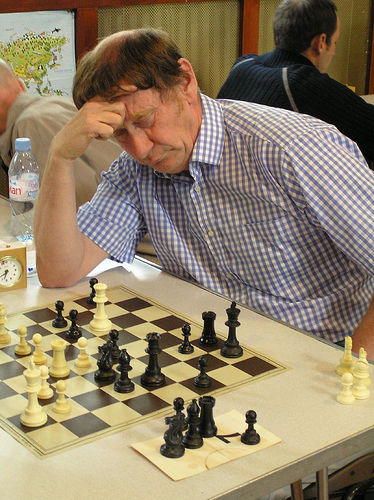
According to the author : “I am a 21-year-old FIDE Master from Ukraine with two IM norms and a peak rating of 2382 currently residing in Saint Louis, USA. During my youth chess career, I won more than ten medals in Ukrainian Youth Championships, having become Ukrainian champion – both individually, in rapid U-20 in 2018 and as a team member during the Ukrainian Team Championship in 2016. I represented the Ukrainian National Team at the U-18 European Team Championship in 2016 where Ukraine earned a bronze medal; I also won an individual board bronze medal.
I have participated in European and World Junior Championships, representing Ukraine. Presently, my focus is teaching, and I have already acquired great experience working to improve my student’s chess skills. I currently share my knowledge and understanding of the game by writing books, articles for the Yearbook and other sources while creating opening and video courses. I have a bachelor’s degree in Translation, and I am currently pursuing my master’s in Finance at Webster University where I am attending on a chess scholarship. Webster is also acknowledged for having the one of best collegiate chess teams in the United States.”

From the book’s rear cover we have :
“One of the important issues players face – both relatively inexperienced ones at the beginning of their career as well as seasoned ones as they realize their chess craves change – is choosing an opening repertoire. As a player and a coach, I have seen many approaches to this question, both remarkable and mistaken. Some players believe that the opening is something to ignore, that everything is decided in the middlegame. Others think that studying opening traps is what wins games. Some tend to follow their favourite world-class player’s recommendations, while others like to sidestep well-known opening theory early on, preferring unpopular side-lines. To me, opening choice is about all those decisions. I think that many openings are good; there are some dubious ones, but they can also yield formidable results overall or in specific situations if chosen and handled carefully.
I firmly believe that your opening repertoire should mostly be based on your playing style and other personal traits, such as memory and work ethic. It is important to evaluate yourself as well as your strengths and weaknesses properly in order to be able to build the right repertoire that would not only suit you well, but also improve your overall chess. The little detail, though, is in the word “mostly”. Namely, I firmly believe that there are a few classical, rock-solid openings with an impeccable reputation, such as 1.e4 e5 as a response to 1.e4 or the Queen’s Gambit and Nimzo as an answer to 1.d4 that players of all styles and standards should try, no matter what their style is. This will enable players to learn, appreciate and practice some of the key chess values, such as the importance of space, lack of weaknesses, bad pieces, and comfortable development and so on – you name it. I, myself, started out as a keen Sicilian player.
Just like all youngsters, I cheerfully enjoyed complications, tactical massacres and everything else that the Sicilian is all about. However, as I was developing as a player, my style was changing also. Eventually, I realized I was much more successful with positional play, so it was time to change the outfit – and 1.e4 e5 suited me well. I have used this move as a response to 1.e4 nearly exclusively in recent years, both versus weaker and stronger opposition, with fantastic results. If only other openings would grant me such results as well! I have not only studied these variations myself but have also shown them to numerous private students. To be frank, we have almost always concentrated on White’s most dangerous possibilities, such as the Ruy Lopez, Italian and Scotch. Occasionally, we have also analysed the side-lines – either as a part of preparation for specific opponents or to make sure my students become more universal players and gain more all-round knowledge.
Eventually, I realized that the knowledge I gained from 1.e4 e5 can and should be shared with more players, and this is how my book came to life. Of course, the readers will differ, so there is a no “one-size-fits-all” solution. But, I have carefully and diligently tried to achieve the same goal I used when working with my students: to keep my recommendations both theoretically sound as well as practical and accessible.
I expect not only titled players but club players and the less experienced readers to equally benefit from this book. So, sometimes you will find razor-sharp novelties, but in many cases, we will rely on positional understanding, typical structures and standard ideas. I believe the opening is not all about memorization, so I have taken a different approach from many authors by keeping the balance between recommending objectively good variations as well as making sure an adequate amount of work will suffice to get you started.
You won’t need to spend years studying the material, fearing there is still much more to learn. 1.e4 e5! is not just an opening. It is repertoire that represents our game as a whole. It is something players of all styles will enjoy due to the countless possibilities 1…e5 provides. Hopefully, learning 1…e5 will also make you a better player. And, finally, I hope the book you are now holding in your hands will not only give you joy but illustrate a passion for chess with the variations presented in this work.”
Having spent almost all of my chess life (both OTB and postally) playing 1…e5 I was very much looking to examining the author’s detailed recommendations.
For many years during the eras of both Bobby Fischer and Gary Kasparov the Sicilian Defence was easily the most popular reply to 1.e4 but now with players like Magnus Carlsen and Levon Aronian often adopting open (1…e5) defences preference have greatly changed.
The author starts by looking at odd openings such as Nakamura’s “Whimsy” 2.Qh5 (perhaps this should be called the school chess club opening?): Not surprisingly he gives a line that shows Black can readily get the upper hand.
He then goes on to look at the Centre Game 2 d4 ed4 3 Qd4 !? this is an odd opening that will catch many Black players by surprise.
I always feel uncomfortable when I face this on the Internet . Yuriy gives some good analysis showing that Black can quickly turn the tables on White.
The following chapters examine the Scotch Game and the King’s Gambit. These openings appear straightforward for Black to equalise against. I was surprised to find that in the King’s Gambit after 2.f4 ef4 3.Nf3 Ne7 was recommended!
It turns out that this idea has been played by the French GM Etienne Bacrot, the idea being to play a quick d5.
The author often offers some unusual lines which seem designed to surprise the opponent . He provides analysis of a game up to move 18 concluding that Black is better and shows how to continue the middle game plan from there.
The Vienna Game is also looked at in some depth . After 2 Nc3 Nf6 both 3.Bc4 and 3.f4 are seen . Against the former he recommends 3…Ne4!?
and against the latter 3…d5 4.fe5 Ne4 5.Nf3 Be7 a solid choice which I have played myself.
After recommending 3…d5 versus the Ponziani Opening
the author looks at the Scotch Game (which is very popular at club level) and recommends 4…Bc5 :
Peter Leko selected this line against Magnus Carlsen a few years ago and despite losing the game it was not because of this opening choice which was quite sound. From here 5.Nc6: and 5.Nb3 are both analysed along with the “traditional move” 5.Be3 .
The author now suggests two alternatives for Black: 5…Bd4 which is an unusual line that could well be a good choice against a higher graded player as after 6.Bd4 Nd4 7.Qd4 Qf6 White will have to work hard to win.
Yuriy then looks at the main line with 5…Qf6 but after 6.c3 he suggests the unusual 6…Qg6 :
Once again this suggestion is move which will set White players thinking early in the game whilst remaining a sound choice.
In The Four Knights Game after 4.Bb5 (the Spanish Four Knights) Yuriy gives Rubinstein’s aggressive 4…Nd4 which Kramnik used successfully to defeat Nigel Short.
A small, but not terrible omission, is the lack of coverage of the dangerous Halloween Gambit: something for the second edition!
We now move on to the Evans Gambit, and side-lines of the Guioco Piano are examined before giving detailed analysis of the quiet Italian . This opening 4 c3 Nf6 5 d3 is very popular at world class level and, currently Jan-Krzysztof Duda being the latest high profile player to adopt it .
The plan (which I adopt) of d6 and a6 is recommended when Black again achieves equal play .
Finally (and most fittingly) we come to the Ruy Lopez usually regarded as the ultimate test for 1…e5 players .
In the Exchange Lopez, Barendregt Variation after 5.00 Qf6 a line advocated by Michael Adams is suggested and you’ll need to buy the book to find out what it is!
In the main line Lopez the Open is the weapon of choice with the somewhat unusual 5…Ne4 6 d4 Be7 !? recommended.
This, perhaps is the one recommendation I might not agree with 100%.
Yuriy then goes onto examine some rather unusual lines in the Lopez giving comprehensive coverage.
In summary this book gives a lot of interesting and thought provoking lines that may surprise the player of the White pieces and push them into waters that they are not familiar with.
Black players may do well to try these ideas on-line first and if they work for them then use them in more “serious” games .
The author claims to have checked all of his ideas with an engine and therefore (hopefully) none are unsound !
Colin Lyne, Farnborough, Hampshire, 19th February, 2021

Book Details :
- Paperback : 280 pages
- Publisher:Thinkers Publishing; 1st edition (19 Nov. 2020)
- Language: English
- ISBN-10:9492510847
- ISBN-13:978-9492510846
- Product Dimensions: 17.78 x 1.91 x 24.13 cm
Official web site of Thinkers Publishing

